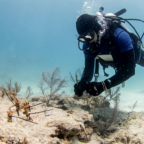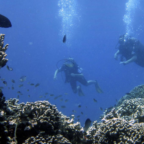
As if the devastation in Texas wasn’t enough, Hurricane Harvey’s aftermath has also brought a real threat to the Gulf of Mexico. A massive freshwater plume has poured runoff into the Gulf, temporarily altering the surrounding water’s salinity – and threatening coral reefs.
Harvey dumped some 20 trillion gallons of rain on the Lone Star State, and that record rainfall had to go somewhere. That somewhere is the Gulf of Mexico. Scientists estimate an incredible 13 trillion gallons entered the Gulf in the days immediately following the storm.
The possible negative effects of that much freshwater entering the saltwater ecosystem became apparent on September 28. That day, nearly a month after Harvey barreled through Texas, the Texas Automated Buoy System measured a 10 percent drop in salinity at the Flower Garden Banks coral reefs, located about 100 miles off the coast.
The buoy system is a network of buoys operated by Texas A&M’s Geochemical and Environmental Research Group. GERG buoys monitor Gulf waters along the Texas coastline on a real-time basis. And that surprising 10 percent salinity change galvanized researchers into action.
“The salinity at one buoy on the reef dropped from 36 to 32 on Sept. 28, but it rebounded to 36 by Oct. 4, and it has been between 35 and 36 since then,” said Rice University marine biologist Adrienne Correa in a press release. “We don’t yet know what impact the low salinity had on the reef while it was there.”
In order to find out, a team of scientific experts from Rice University, Texas A&M, the University of Houston-Clear Lake and Boston University and the National Oceanic and Atmospheric Administration’s Office of National Marine Sanctuaries will spend five days sampling the affected area.
They’ll collect samples of coral, sponges, sediment, microbes and water to determine how the freshwater runoff may have impacted the sensitive reefs at the Flower Garden Banks. As damaging as this situation could be, it presents an excellent research opportunity for marine scientists.
“We’ve literally never seen that much freshwater added to the Gulf of Mexico at once,” Kathryn Shamberger, a Texas A&M University oceanographer, told The Atlantic.
But why so much interest more water flowing into the Gulf of Mexico?
It’s because the Gulf is a saltwater environment, and those trillions of gallons of runoff are freshwater. Corals require saltwater to survive. In particular, these marine invertebrates need a specific ratio of salt to water. Corals therefore can’t live in locations where freshwater drains into a saltwater ecosystem.
Luckily, it appears the wind has directed the freshwater plume in a southerly and westerly direction, according to Shamberger. However, the reefs aren’t necessarily out of the woods until the freshwater becomes so diluted that it ceases to present a threat.
There’s been much speculation as to whether the size and scope of Hurricanes Harvey, Irma and Maria can be blamed on climate change. The U.S. hasn’t experienced this intense a hurricane season in modern history. If Harvey’s devastating impact is indeed the result of climate change, then so are the negative effects of the storm’s runoff.
These days most scientists affirm the reality of climate change. Yet environmentalists must still battle their political leaders to enact — or keep — laws intended to reduce the effects of climate change. One wonders what it will take to convince the naysayers.
Does a whole state or territory need to go permanently underwater before our leaders will believe?















Social Profiles